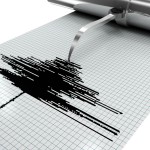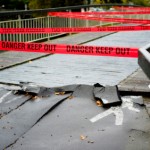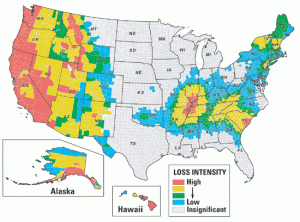 Many of us flatlanders in the Midwest section of the United States don’t view earthquakes as a real threat to our lives or property. Our disaster preparedness plans generally don’t revolve around the possibility of an earthquake. Our natural disaster emergency plans are based on the appearance of a tornado or flash flood. Most of us simply don’t know what to do in the event of an earthquake.
Many of us flatlanders in the Midwest section of the United States don’t view earthquakes as a real threat to our lives or property. Our disaster preparedness plans generally don’t revolve around the possibility of an earthquake. Our natural disaster emergency plans are based on the appearance of a tornado or flash flood. Most of us simply don’t know what to do in the event of an earthquake.
Preparing for an earthquake never entered my mind. This all changed in April of 2008 when a 5.2 magnitude quake hit in New Salem Illinois and shook most of Illinois, Indiana Missouri. In 2010 a 3.8 magnitude quake came out of nowhere. This temblor put many, including me on notice we live in an earthquake zone.
The last straw for me came in August 2012, while visiting friends in California, I found myself in the middle of an earthquake swarm. It chapped my ass to see my west coast friends laugh at the Midwest Boy and his confusion and fear. After all, a 5.3 on the Richter scale is nothing to these people.
Scientists believe the risk of quakes is growing as the state drains groundwater reserves near the San Andreas Fault. California’s drought has reached epic proportions. Nearly 60 percent of the state is in exceptional drought—the most severe category—and farmers are depleting groundwater reserves at record rates as wildfires break out north and south. Read More[Click Here]
Ways to prepare for an earthquake
During the quake
Indoors
- Stay inside
- DROP, COVER, AND HOLD ON! Move only a few steps to a nearby safe place. Take cover under and hold onto a piece of heavy furniture or stand against an inside wall. Stay indoors until the shaking stops and you’re sure it’s safe to exit. Stay away from windows and doors.
- **Never take an elevator
- If you are in bed, hold on, stay there, and protect your head with a pillow.
Outdoors
- Find a clear spot away from buildings, trees, and power lines.
- Drop to the ground until the shaking stops.
In A Car
- Slow down and drive to a clear place (as described above).
- Turn on emergency flashers on and slow to a stop. Do not stop on overpasses, underpasses, or bridges. Be careful of overhead hazards such as power lines or falling building debris.
- Turn off the ignition and set the parking brake.
- Stay inside the car until the shaking stops.
Pets: During and after
- Don’t try to hold your pet during a quake. Animals instinctively want to hide when their safety is threatened. If you get in their way, even the nicest pets may hurt you.
- Watch animals closely. Leash dogs and place them in a fenced yard.
- Pets may not be allowed into shelters for health and space reasons. Prepare an emergency pen for pets in the home that includes a 3-day supply of dry food and a large container of water.
- If you can’t find your pet or must leave it at home after a quake, leave fresh water in no-spill containers such as bathtubs and sinks. Leave plenty of low-fat dry food, which deteriorates more slowly and is less tasty so pets won’t try to eat it all at once. Leave a note indicating that you have a pet, where you will be and the date.
After the quake
Personal Safety
- Expect aftershocks. Each time you feel one, DROP, COVER, AND HOLD ON!
- Check yourself for injuries. Protect yourself by wearing long pants, a long-sleeved shirt, sturdy shoes and work gloves.
- Listen to a battery-operated radio or television for the latest emergency information.
- Check others for injuries. Give first aid where appropriate. Do not move seriously injured persons unless they are in immediate danger of further injury.
- Remember to help your neighbors who may require special assistance–infants, the elderly, and people with disabilities.
Home
- Inspect your home for damage. Get everyone out if your home is unsafe.
- Telephone: Use the telephone only for emergencies. Check to make sure the receiver has not been shaken off the hook and is tying up the line.
- Fires: Look for and extinguish small fires.
- Gas: Check for gas leaks. If you smell gas or hear blowing or hissing noise, open a window and leave the building. Turn off the gas at the outside main valve if you can and call the gas company.
- Remember, only a professional can turn the gas back on.
- Electricity: Look for electrical system damage. Turn off the electricity at the main fuse box or circuit breaker if you see sparks or broken or frayed wires, or if smell hot insulation. If you have to step in water to get to the fuse box or circuit breaker, call an electrician first for advice.
- Sewage, Water: Check for sewage and water line damage. If you suspect sewage lines are damaged, avoid using the toilets and contact a plumber. If water pipes are damaged, contact the water company and avoid using water from the tap.
 Armed with this information, I have a mental plan of action in place in the event I find myself in an earthquake either at home or while traveling to areas where an earthquake is more likely to strike.
Armed with this information, I have a mental plan of action in place in the event I find myself in an earthquake either at home or while traveling to areas where an earthquake is more likely to strike.
As THEY are finding new faults and rifts every day, an earthquake could pop up just about any time anywhere. Yeah, I think I’ll keep my GHB (Get Home Bag) handy just in case.
I would rather have a little sling bag filled with 24 hours worth of gear that will allow me to eat a little, drink a little and create a primitive shelter than find myself shuffling through the rubble with only my work slacks and shoes
Source: American Red Cross, Fema, San Francisco Chronicle
I am an affiliate for Amazon. This means if you buy something I mentioned in the article, I earn a commission. Please know that I only recommend products that I believe in. I don’t try to hide the fact I earn money from this blog, my credibility is more important than making a quick buck and putting you in harm’s way
Thanks for your support and feel free to post questions below.

Leave a Reply